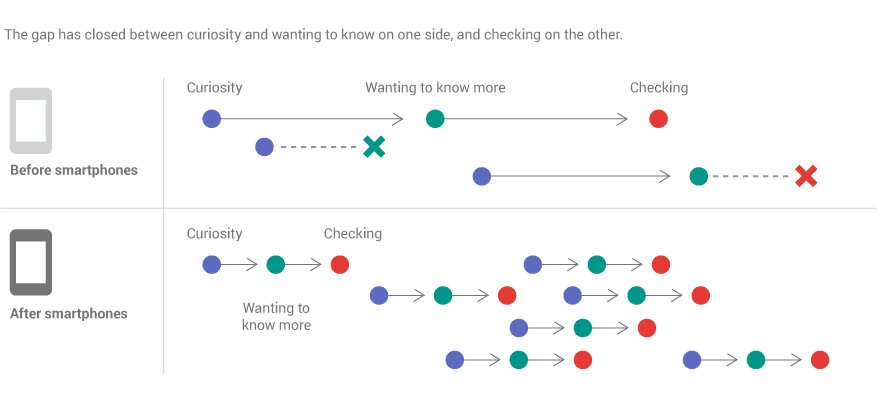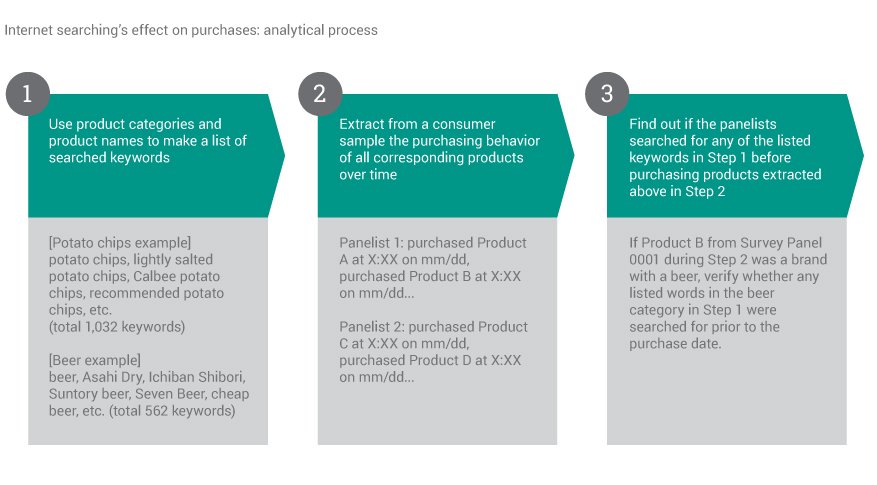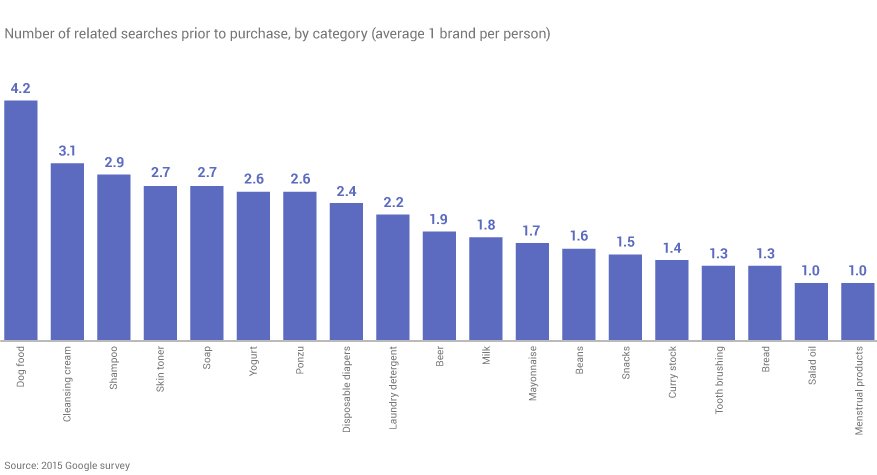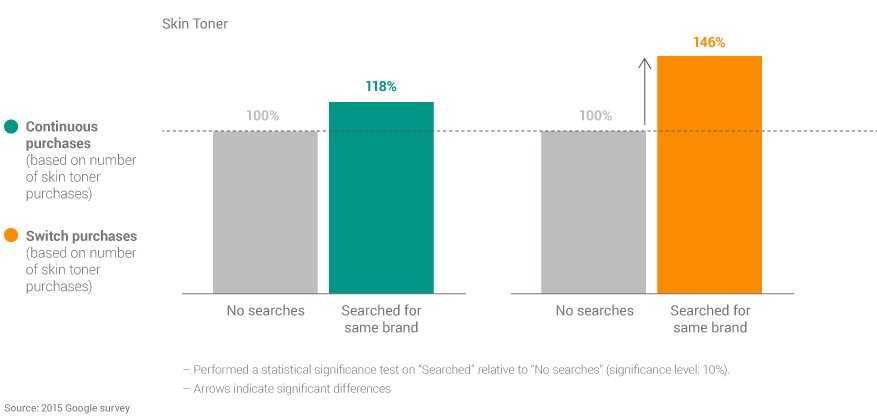There’s no doubt that consumer interaction with brands has evolved since the advent of the smartphone. But what’s the effect of searching for information as soon as one’s curiosity is piqued? And do these effects vary from product to product? This is the fourth installment of the Google marketing team’s popular series of articles discussing the changing nature of marketing in the digital era.
Let’s begin with a simple household item: toothpaste. The sheer number of toothpaste brands sold in drugstores, supermarkets, and internet stores—there are 954 types of toothpaste available in Japan1—will undoubtedly come as a surprise. But this deluge of choice is not unique to toothpaste. In fact, it’s the norm in the consumable goods category, which includes beer (and other alcohols), soft drinks, hair-care products, detergents, and so on. In the face of so much choice, how do consumers select the brands they purchase? Let’s consider this dilemma from the perspective of the average consumer.
When a person meets a brand: the Moment of Truth
The Moment of Truth refers to the instant when a consumer is spurred to actively support—or avoid—a specific brand. Put simply, it’s the moment when a consumer sees or tries a brand and thinks, “I’m glad I chose this!” or “This is just the thing for me!” Or, alternatively, “This isn’t quite what I wanted” or “I’m never buying this product again.”
Since 2005, marketers have emphasized that, among all the moments of truth that exist in a consumer’s daily life, the most significant is the in-store Moment of Truth. It was believed that this “in-store moment” could increase the probability that a shopper would select a specific brand from among the many on the shelves. Consumable-goods marketers refer to this as the First Moment of Truth. As a result, marketers have focused on creating opportunities and incentives for shoppers to try their brands while shopping in the store.
However, even with these efforts, there are brands and services that, despite scarce in-store visibility, are popular because of information exchanges and conversations that happen among individuals and online communities. We can thus conclude that, before even visiting the store, consumers have developed a habit of researching specific brands and products.
The desire to conduct research before purchasing a product has always existed, but few consumers actually bothered to do it because of the lack of tools that allowed them to investigate a brand or product exactly when they wanted the information. Now, the desire to know and the ability to find out is a common part of our every day. That moment could come up, for instance, when you feel that the skin toner you’ve been using doesn’t suit you anymore, or when you find the coffee at your friend’s place really tasty. Or it might be when your baby looks uncomfortable as you change her diaper. Now, with the onset of the internet and smartphones, these I-want-to-know moments can be satisfied quickly.

With curiosity and inquiry happening almost simultaneously, and with increased frequency, online searches are, in the eyes of marketers, more than just a tool for acquiring information. They can also prompt consumers to try a new brand. How? In many cases, the consumers conducting these casual searches don’t necessarily want to know specifics such as price, specs, or which stores sell the item. Instead, they want to get a sensory confirmation of its qualitative value-in other words, whether the product or brand suits them, or whether it will change their life.
If, at this moment, the consumer finds a confirmation of qualitative brand value from the search results, it would be a true Moment of Truth—occurring even earlier than the in-store Moment of Truth. It would be the Zero Moment of Truth.
What sort of effect does search behavior have on purchasing?
It’s commonly believed that consumers only seek out information in advance on the rare “momentous” occasions, in what we would call relatively expensive categories. But research shows that this behavior also applies to relatively inexpensive categories where purchase opportunities occur many times a year. We turned to the consumer panel data2 to better understand the extent to which searches on “frequent purchase” brands influenced the actual purchase of those products. The consumer panel collected data on the purchase behaviors of the same individuals over several years. This data was also tied to the online search behaviors of individual panelists. (For the purposes of our analysis, we used data spanning one year (October 2013 to September 2014).
The exact steps that were used in our analysis are as follows:

The results are:

Thus, in many product categories, there were significant volumes of related search activities prior to purchase.
Next, we investigated the impact of this pre-purchase search activity on purchases after customers tried out a brand. Specifically, we divided purchases of “skin toner” and “disposable diapers,” for which there was a large volume of pre-purchase search activity, into “Repeat purchases” (buying the same product again) and “Switched purchases” (switching to a different product). Then, we compared the number of searches for each. Below are the results.


The results show that pre-purchase searches have a greater effect on brand switching. However, searches are also connected to repeat purchases. A consumer, over the course of their everyday life, will have small, incidental doubts about the products they use. This causes the consumer to conduct searches to investigate the product, which then results in a decision either to switch products or make a repeat purchase.
Connecting consumer signals to brand-encounter opportunities
The penetration rate of devices in Japan may be 89% for computers and 54% for smartphones,3 but searches conducted on smartphones already outnumber those done on computers.4 Furthermore, 67% of all searches for disposable diaper related keywords and 76% of searches for skin toner related keywords are made on smartphones.5 These figures show that search activity has become overwhelmingly spontaneous and casual since the penetration of smartphones.
Now that we can easily search for information whenever we want, the new challenge for marketers is to understand the small moments of doubt consumers have. What sort of information can marketers offer and how can it be offered so that search behavior leads to new “truths” for consumers? Marketing in the digital era must evolve so as to convince consumers that a product or brand is the right one for them, here and now.
This article was originally published on May 22, 2015 in Japanese.








